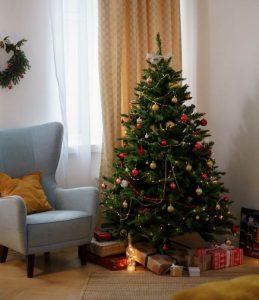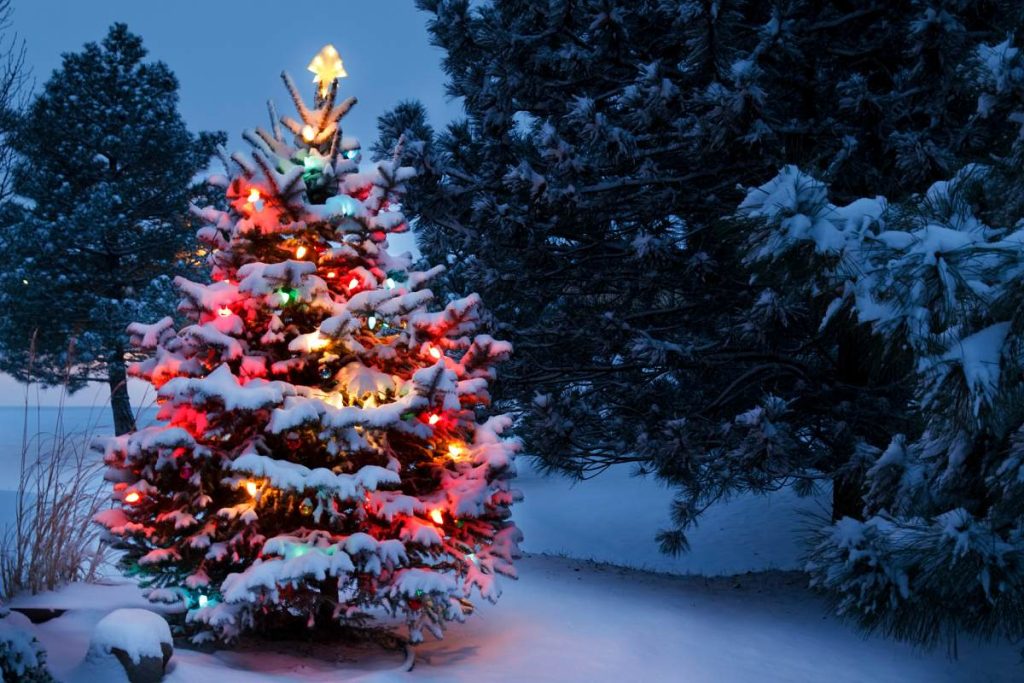Nothing brightens those dark winter evenings quite light a Christmas tree twinkling in the garden. Whether the idea is to welcome visitors and enthral passers-by or look upon from your cosy interior, an outdoor Christmas tree draws the eye and puts a little extra magic in the air.
Find more Christmas Trees for your garden at Christmas Trees Direct.
What Kind of Christmas Tree Should I Choose for the Garden?
There are 3 popular types of real Christmas trees to choose from. Freshly cut, pot-grown and potted. Each has its pros and cons.
Freshly Cut Trees
Fresh-cut trees are the most common type of real Christmas tree bought in the UK, which is hardly surprising considering they need replaced every year. This kind of traditional Christmas tree is usually the cheapest option to purchase and, without the weight of a pot filled with soil, is the easiest to move around and bring home.
The tree is grown in a field, and when it reaches the desired height, the bottom of the trunk gets sawn through to cut the tree down. A freshly cut tree needs a Christmas tree stand to hold it upright and might need to be tied to a fence or outbuilding for additional support, especially in strong winds. A cut tree also requires a constant supply of water to prevent needle drop, which can be time-consuming during dry spells or frosty temperatures.
Pot-Grown Trees
As you’d imagine from the name, pot-grown Christmas trees are grown in pots from seedlings. This means the root ball is intact, so the tree has a great chance of survival and can be enjoyed for years to come.
Many people keep the same Christmas tree for a few years, re-potting it as it grows and decorating it every year. Other gardeners prefer to plant their real Christmas tree out in the garden, where it can grow to its full potential.
Pot-grown trees are usually smaller and more expensive than other types of Christmas trees but last longer and are the most eco-friendly option.
Potted Trees
Potted trees have been grown in the ground, dug up and placed in pots for transportation and ease of use. They are less expensive than container-grown Christmas trees and don’t need a tree stand to support them and keep them upright. The weight of the pot is also heavy enough to prevent the tree from being blown over by a strong gust of wind.
However, a potted Christmas tree is less likely to survive long-term than a pot-grown one. Root damage during harvesting makes it difficult to keep your Christmas tree alive for long after the festive period.
How to Look After a Real Christmas Tree
Unlike artificial trees, real Christmas trees need care and attention to help them look their best throughout the festive season.
Top Tips to Keep a Real Christmas Tree Fresh and Green
The care you give a real Christmas tree will largely depend on whether you have a freshly cut, potted or pot-grown tree.
 Trees in Pots
Trees in Pots
Caring for a potted tree is very similar to looking after a pot-grown Christmas tree. The most important thing is to remember to water your tree. Trees in pots can’t absorb as much water from the soil as those planted in the ground, as the soil dries out faster. Keep an eye on the weather and water regularly during dry spells to keep your tree happy and healthy.
Real trees benefit from fertilising with quality liquid feed during the growing season. In spring and summer, incorporate feeding into your care routine. Pruning isn’t generally required for trees in pots but you may want to trim the branches occasionally to keep that perfect Christmas tree shape.
Trees in Stands
Water, water, and water some more. That is the golden rule for freshly cut Christmas tree care. Cut trees are notoriously thirsty and need a steady supply of water to prevent them from drying out. Keeping the Christmas tree stand filled with water helps keep the tree hydrated and minimises needle drop.
Cutting the base of the trunk when you get the tree home allows it to absorb moisture more effectively. Store the tree in a bucket of water until you’re ready to position it in place.
Choose a bright spot out of the direct sun and ensure the tree is sheltered from strong winds. Before positioning the Christmas tree, hold it by the trunk and give it a gentle tap on the ground. You’ll probably notice some internal needles dropping, but this is nothing to worry about as they naturally shed.
What Do You Put in Christmas Tree Water to Keep It Fresh?
You may have seen or heard that adding sugar, aspirin, cola or even bleach to Christmas tree water can help a real tree stay fresh. However, none of these things will help your Christmas tree last longer. In fact, even sugar water can do more damage than good. All that is needed for a healthy tree is plenty of fresh water. Plain water from the tap is just fine.
How Often Do Christmas Trees Need to be Watered?
Cut Christmas trees need a water reservoir that gets topped up with fresh water frequently. Potted and container-grown Christmas trees need to be watered regularly but are less demanding in their watering needs, as they can take up moisture from the soil.
Keep an eye on the weather and adjust your watering schedule accordingly. Your outdoor Christmas tree should be fine in wet, damp weather with plenty of rain or snow to keep it hydrated. But if the weather is drier, you’ll need to water the tree properly more often.
The Best Christmas Trees for the Garden
Choosing the right Christmas tree for the garden not only ensures it looks good, but also that it fits the space well, and in the case of pot-grown Christmas trees, ensures longevity. Don’t be afraid to take a tape measure to the nursery with you so you can check the tree is the right size for the space available.
Norway Spruce
Norway spruce is one of the most popular Christmas tree species in the UK, as it lasts well indoors and outdoors. Norway spruce has a traditional Christmas tree shape and a pleasant pine scent. The dark green glossy needles are densely packed, producing a thick and healthy appearance. However, Norway spruce trees are prone to needle drop, so need to be kept well-hydrated throughout the season.
Blue Spruce
Blue spruce is the ideal choice of pot-grown Christmas tree for the garden. This real Christmas tree variety is known for its hardiness and requires very little maintenance. The steely-blue needles are pine scented and turn an attractive shade of dark green as they mature.
Nordmann Fir
The Nordmann fir is Britain’s best-selling real Christmas tree variety. The large, soft needles aren’t spiky, making this tree an ideal option for families and pets. Well known for its needle retention, the Nordmann fir is often called the non-drop Christmas tree. A Nordmann fir has a lovely fresh fragrance and is the perfect choice for a freshly cut tree.
Fraser Fir
With its silvery-green foliage and citrussy scent, the Fraser fir is fast becoming a hugely popular Christmas tree variety. They are grown at many UK Christmas tree farms and cope well with the local climate. Fraser firs are narrower than other kinds of Christmas trees but have a full appearance thanks to the densely packed soft needles.
How Long Do Real Christmas Trees Survive?
Again the answer to this question lies in the type of real Christmas tree you’ve chosen.
A freshly cut tree kept outside should last around 5 weeks, comfortably seeing in the new year. When you bring the tree home cut around one inch off the base of the trunk to aid water absorption over the coming weeks.
The lifespan of a potted tree varies according to how much damage the roots incurred when the tree was dug up and placed in its pot. A containerised tree with only a little damage could last for a couple of years, while one that sustained more damage may only last for a few weeks or months.
A pot-grown tree has the longest lifespan of any type of Christmas tree. Kept in pots and re-potted every year or 2 to accommodate new growth, a pot-grown tree lasts a few years. One that is planted out in the garden and is able to absorb nutrients from the ground can survive for decades.
Christmas Tree Care Beyond the Festive Season
Look after your Christmas tree properly, and it can last for years.
Potted and Pot-Grown Trees
Regular watering is vital for keeping your real Christmas tree healthy, particularly in the first year when it becomes established either in its pot or in the ground. remember that a real tree in a pot needs to be watered more often than one planted in the ground. Add a monthly feed during the growing season to promote new growth.
When moving the tree into a bigger pot, avoid putting sand in the container. Instead, use good quality compost high in nutrients to help ensure your tree stays fresh.
Once established, a real tree doesn’t need much maintenance. You may wish to prune it occasionally to keep a traditional Christmas tree shape and, of course, water it during dry spells of weather.
Freshly Cut Trees
No amount of Christmas tree care will keep a cut tree alive for very long. When the festivities are over, check with your local council for disposal arrangements. Many councils offer a free uplift service in the first week or two of the new year, while others have designated drop-off points.
If you’re not quite ready to say goodbye to your real tree yet, consider re-purposing it in the garden. Strip the needles off and use the bare tree as a stake or frame for climbing plants. Alternatively, leave the real tree in a corner of the garden to provide a home for local wildlife.
Whether you opt for a pot-grown tree next to the front door or a huge Christmas tree with strong branches for plenty of lights, proper care is the key to minimising fallen pine needles and keeping your real tree healthy for Christmases to come.
We recommend Christmas Trees Direct for Christmas Trees for your garden.




